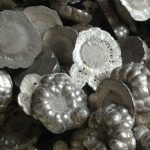Notice: Undefined index: sith_hide_share in /www/sites/alloy.wiki/index/wp-content/themes/likegoogle/single.php on line 32
Deprecated: get_settings is deprecated since version 2.1.0! Use get_option() instead. in /www/sites/alloy.wiki/index/wp-includes/functions.php on line 4862
Traditional titanium alloy material
α titanium alloy has the longest clinical application time. However, titanium itself has low strength, poor abrasion resistance, easy fracture after implantation and other disadvantages. It cannot be applied to parts with large bearing capacity. On this basis, TI-6al-4V, with its lower elastic modulus, better mechanical compatibility and physiological corrosion resistance, has become a substitute for clinical titanium metal materials. Until today, ti-6al-4V material is still one of the most widely used titanium alloys in the world.
However, the research results show that V has physiological toxicity to human body. In order to avoid the harm of V, the researchers developed Ti-5al-2.5 Fe and Ti-6al-7NB as a series of α+β titanium alloys. However, the elastic modulus of α+β titanium alloy is still several times that of (4~10) natural bone (20~30Gpa). The mismatch of elastic modulus between the two causes "stress shielding", which leads to no fundamental improvement in bone resorption and loosening around the implant.

New titanium alloy material
Based on the traditional titanium alloy, a new type of β titanium alloy material was developed by adding Nb, Mo, Ta and other stable elements with good biocompatibility. For example, ti-12mo-6ZR-2FE (TMZF) alloy developed in the United States has a modulus of 74~85GPa, which is 75% of the second generation of traditional titanium alloy. In China, Ti-24NB-4ZR-7.6 Sn new type titanium alloy made by Zheng et al. has completed clinical trials in several hospitals and entered the stage of large-scale application.
Surface modification of titanium alloy
Surface modification has always been one of the main ways to enhance the properties of materials. In the field of medical titanium alloy research, surface modification is mainly used to improve the biocompatibility, corrosion resistance and wear resistance of titanium alloy. In order to improve the biocompatibility, for example, bioactive coating is one of effective way, at present, the hydroxyapatite (HA) layer are the most common coating material research and application, its itself is similar to the human body hard tissue of chemical composition, crystal structure, good bioactivity and compatibility, make after implantation combined with bone tightly, and the induced bone healing. , however, the current clinical practice shows that due to residual stress, coating and the substrate is not ideal, combined with edge easy to dissolve the problems still exist, such as on the basis of the HA coating, add ZrO2, Y2O3, CaO compounds such as composite coating technology, introducing the transition layer or multilayer technology of buffer layer functional gradient coating and organic inorganic composite coating technology is also in constant development.
Porous and composite titanium alloy materials
The author mentioned above that "stress shielding" is the main problem in the application of titanium alloy in the medical field. The porous titanium and titanium alloy can effectively alleviate the stress shielding problem caused by the difference of elastic modulus between the alloy and the bone. The existence of the gap on the one hand can make the material of higher than the surface, strength and elastic modulus is reduced, on the other hand, the three dimensional open porous structure can promote bone production and provide space for bone value-added cell differentiation in the void, forming machinery is fixed, at the same time, the existence of the gap can make the tissue fluid, nutrients into the implants, accelerate implants and organisms.
In the study of pore making of pure titanium metal, Li Hu et al. independently prepared different kinds of porous titanium metal by foaming and powder treatment, respectively. The results all showed that the existence of pore results reduced the elastic modulus of the material, improved the compatibility between organism and material, and accelerated the healing process.
Porous titanium alloy technology is an excellent functional material and structural material developed in recent years, which has broad scientific research and application value, and is also a key and difficult point in the current research field of medical titanium alloy. HUANG H et al. prepared porous titanium alloy by laser sintering, EBM and other different methods. Studies all showed that the appropriate pore structure was not only conducive to improving the compatibility of titanium alloy in the organism, but also significantly extended the service life of the implant.
Guest contributors are welcome at the Alloy Wiki.It is a weekly wiki and guide on alloy information and processing technology, while also about the vast array of opportunities that are present in manufacturing. Our team of writers consists of a Machining Material Supplier / Machinist / Tool and Die Maker, a Biomedical Engineer / Product Development Engineer, a Job Development Coordinator / Adjunct Professor, and a President and CEO of a manufacturing facility.
Link to this article:Research progress of medical titanium alloy
Reprint Statement: If there are no special instructions, all articles on this site are original. Please indicate the source for reprinting:Alloy Wiki,thanks!^^


